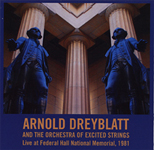|
|
 |
Dusted Reviews
Artist: Arnold Dreyblatt and The Orchestra of Excited Strings Album: Live at Federal Hall National Memorial, 1981 Label: Table of the Elements Review date: Sep. 9, 2006 |

|
|
|
 |
The insistent rhythm of Terry Riley’s In C is perhaps minimalism’s most renowned pulse, a simple piano repetition upon which the work of an entire ensemble rides. Over 10 years after Riley composed In C, Arnold Dreyblatt (who had studied under Pauline Oliveros and Lamonte Young) began his own work with minimalism, also highly dependent on a pulse, a simple constant that can either serve as the backbone for a larger performance, or serve as the entire performance itself. Dreyblatt’s work has been rather scantly released over the years, and the majority of CDs and LPs now available are documents of the work he’s done in the last decade or so, with only his debut album, 1982’s Nodal Excitation and 1985’s Propellers in Love appearing in the first decade of his musical career. The Sound of One String, a compendium of the composer’s work from the '70s to the '90s, offers a few more chances to encounter the composer’s early works, but his discography remains heavily weighted at one end. For that reason alone, the arrival of this album is a welcome one; it’s a live document of a performance that pre-dates his first album by a year, a recording of Dreyblatt’s ecstatic minimalism in early form, left unreleased for more than 20 years.
For this performance, Dreyblatt’s Orchestra of Excited Strings consisted of a quintet: two just-intoned basses, a mini princess piano, portable pipe organ, and hurdy gurdy. The piano, with a tone not unlike a toy, is persistent, rarely varying from a simple rhythmic repetition. And while Dreyblatt is certainly no stranger to the use of drones, his minimalism is of a far more overtly active variety, unquestionably linked to the music’s beat, which, explicitly stated, is an unwavering constant. The disc begins with the piano alone, a single note keyed at a steady rate, growing in volume until the sound seems thunderous. As the music becomes denser, single voices can be difficult to identify, due both to the complimentary arrangements that he prefers, and the sound quality of the recording. A single voice, calling out like clockwork, reaches the ear with little trouble, but as the accompanying drones build, and the rhythm is picked up by other players, the subtle shifts and harmonic detail that mark much of Dreyblatt’s work can be lost in the mix. The unwavering rattle and clang of the work calls through the murkiness, however, and the listener can still delight in the precision of the ensemble’s relentless din.
The resonance of Federal Hall was likely an enhancement to the performance when it originally occurred, though, 24 years later, hearing the music from a pair of speakers, the reverb in the room (and therefore, on the recording) serves, at times, as a muddling force in the music. The overall effect is not lost, though it’s sometimes hard to get past the chief rhythmic structure of the song, with the more unobtrusive drones blending in with the room tone, and the parts played in the lower register meshed into a singular voice. But, like most artifacts, this one is quite valuable, even if not in impeccable condition, and any addition to Dreyblatt’s discography, especially from so early in his career, is a welcome one.
By Adam Strohm
|







